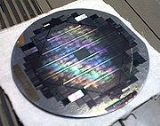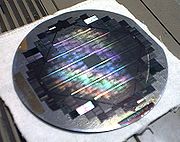
Wafer-scale integration
Encyclopedia
Wafer-scale integration, WSI for short, is a yet-unused system of building very-large integrated circuit
networks that use an entire silicon wafer
to produce a single "super-chip". Through a combination of large size and reduced packaging, WSI could lead to dramatically reduced costs for some systems, notably massively parallel
supercomputer
s. The name is taken from the term very-large-scale integration
, the current state of the art
when WSI was being developed.
Multiple copies of these patterns are deposited on the wafer in a grid fashion across the surface of the wafer. After all the possible locations are patterned, the wafer surface appears like a sheet of graph paper, with grid lines delineating the individual chips. Each of these grid locations is tested for manufacturing defects by automated equipment. Those locations that are found to be defective are recorded and marked with a dot of paint. The wafer is then sawed apart to cut out the individual chips. Those defective chips are thrown away, or recycled, while the working chips are placed into packaging and re-tested for any damage that might occur during the packaging process.
Flaws on the surface of the wafers and problems during the layering/depositing process are impossible to avoid, and cause some of the individual chips to be defective. The revenue from the remaining working chips has to pay for the entire cost of the wafer and its processing, including those discarded defective chips. Thus, the higher number of working chips or higher yield, the lower the cost of each individual chip. In order to maximize yield one wants to make the chips as small as possible, so that a higher number of working chips can be obtained per wafer.
The vast majority of the cost of fabrication (typically 30%-50%) is related to testing and packaging the individual chips. Further cost is associated with connecting the chips into an integrated system (usually via a printed circuit board
). Wafer-scale integration seeks to reduce this cost, as well as improve performance, by building larger chips in a single package – in principle, chips as large as a full wafer.
Of course this is not easy, since given the flaws on the wafers a single large design printed onto a wafer would almost always not work. It has been an ongoing goal to develop methods to handle faulty areas of the wafers through logic, as opposed to sawing them out of the wafer. Generally, this approach uses a grid pattern of sub-circuits and "rewires" around the damaged areas using appropriate logic. If the resulting wafer has enough working sub-circuits, it can be used despite faults.
 Many companies attempted to develop WSI production systems in the 1970s and 80s, but all failed. TI
Many companies attempted to develop WSI production systems in the 1970s and 80s, but all failed. TI
and ITT
both saw it as a way to develop complex pipelined
microprocessor
s and re-enter a market where they were losing ground, but neither released any products.
Gene Amdahl
also attempted to develop WSI as a method of making a supercomputer, starting Trilogy Systems
in 1980 and garnering investments from Groupe Bull
, Sperry Rand and Digital Equipment Corporation
, who (along with others) provided an estimated $230 million in financing. The design called for a 2.5" square chip with 1200 pins on the bottom.
The effort was plagued by a series of disasters, including floods which delayed the construction of the plant and later ruined the clean-room interior. After burning through about 1/3 of the capital with nothing to show for it, Amdahl eventually declared the idea would only work with a 99.99% yield, which wouldn't happen for 100 years. He used Trilogy's remaining seed capital to buy Elxsi
, a maker of VAX
-compatible machines, in 1985. The Trilogy efforts were eventually ended and "became" Elxsi.
Integrated circuit
An integrated circuit or monolithic integrated circuit is an electronic circuit manufactured by the patterned diffusion of trace elements into the surface of a thin substrate of semiconductor material...
networks that use an entire silicon wafer
Wafer (electronics)
A wafer is a thin slice of semiconductor material, such as a silicon crystal, used in the fabrication of integrated circuits and other microdevices...
to produce a single "super-chip". Through a combination of large size and reduced packaging, WSI could lead to dramatically reduced costs for some systems, notably massively parallel
Massively parallel
Massively parallel is a description which appears in computer science, life sciences, medical diagnostics, and other fields.A massively parallel computer is a distributed memory computer system which consists of many individual nodes, each of which is essentially an independent computer in itself,...
supercomputer
Supercomputer
A supercomputer is a computer at the frontline of current processing capacity, particularly speed of calculation.Supercomputers are used for highly calculation-intensive tasks such as problems including quantum physics, weather forecasting, climate research, molecular modeling A supercomputer is a...
s. The name is taken from the term very-large-scale integration
Very-large-scale integration
Very-large-scale integration is the process of creating integrated circuits by combining thousands of transistors into a single chip. VLSI began in the 1970s when complex semiconductor and communication technologies were being developed. The microprocessor is a VLSI device.The first semiconductor...
, the current state of the art
State of the art
The state of the art is the highest level of development, as of a device, technique, or scientific field, achieved at a particular time. It also refers to the level of development reached at any particular time as a result of the latest methodologies employed.- Origin :The earliest use of the term...
when WSI was being developed.
The concept
To understand WSI, one has to consider the normal chip-making process. A single large cylindrical crystal of silicon is produced and then cut into disks known as wafers. The wafers are then cleaned and polished in preparation for the fabrication process. A photographic process is used to pattern the surface where material ought to be deposited on top of the wafer and where not to. The desired material is deposited and the photographic mask is removed for the next layer. From then on the wafer is repeatedly processed in this fashion, putting on layer after layer of circuitry on the surface.Multiple copies of these patterns are deposited on the wafer in a grid fashion across the surface of the wafer. After all the possible locations are patterned, the wafer surface appears like a sheet of graph paper, with grid lines delineating the individual chips. Each of these grid locations is tested for manufacturing defects by automated equipment. Those locations that are found to be defective are recorded and marked with a dot of paint. The wafer is then sawed apart to cut out the individual chips. Those defective chips are thrown away, or recycled, while the working chips are placed into packaging and re-tested for any damage that might occur during the packaging process.
Flaws on the surface of the wafers and problems during the layering/depositing process are impossible to avoid, and cause some of the individual chips to be defective. The revenue from the remaining working chips has to pay for the entire cost of the wafer and its processing, including those discarded defective chips. Thus, the higher number of working chips or higher yield, the lower the cost of each individual chip. In order to maximize yield one wants to make the chips as small as possible, so that a higher number of working chips can be obtained per wafer.
The vast majority of the cost of fabrication (typically 30%-50%) is related to testing and packaging the individual chips. Further cost is associated with connecting the chips into an integrated system (usually via a printed circuit board
Printed circuit board
A printed circuit board, or PCB, is used to mechanically support and electrically connect electronic components using conductive pathways, tracks or signal traces etched from copper sheets laminated onto a non-conductive substrate. It is also referred to as printed wiring board or etched wiring...
). Wafer-scale integration seeks to reduce this cost, as well as improve performance, by building larger chips in a single package – in principle, chips as large as a full wafer.
Of course this is not easy, since given the flaws on the wafers a single large design printed onto a wafer would almost always not work. It has been an ongoing goal to develop methods to handle faulty areas of the wafers through logic, as opposed to sawing them out of the wafer. Generally, this approach uses a grid pattern of sub-circuits and "rewires" around the damaged areas using appropriate logic. If the resulting wafer has enough working sub-circuits, it can be used despite faults.
Production attempts

Texas Instruments
Texas Instruments Inc. , widely known as TI, is an American company based in Dallas, Texas, United States, which develops and commercializes semiconductor and computer technology...
and ITT
ITT Corporation
ITT Corporation is a global diversified manufacturing company based in the United States. ITT participates in global markets including water and fluids management, defense and security, and motion and flow control...
both saw it as a way to develop complex pipelined
Instruction pipeline
An instruction pipeline is a technique used in the design of computers and other digital electronic devices to increase their instruction throughput ....
microprocessor
Microprocessor
A microprocessor incorporates the functions of a computer's central processing unit on a single integrated circuit, or at most a few integrated circuits. It is a multipurpose, programmable device that accepts digital data as input, processes it according to instructions stored in its memory, and...
s and re-enter a market where they were losing ground, but neither released any products.
Gene Amdahl
Gene Amdahl
Gene Myron Amdahl is a Norwegian-American computer architect and high-tech entrepreneur, chiefly known for his work on mainframe computers at IBM and later his own companies, especially Amdahl Corporation...
also attempted to develop WSI as a method of making a supercomputer, starting Trilogy Systems
Trilogy Systems
Trilogy Systems Corporation was a computer systems company started in 1980. Originally called ACSYS, the company was founded by Gene Amdahl, his son Carl Amdahl and Clifford Madden. Flush with the success of his previous company, Amdahl Corporation, Gene Amdahl was able to raise $230 million for...
in 1980 and garnering investments from Groupe Bull
Groupe Bull
-External links:* * — Friends, co-workers and former employees of Bull and Honeywell* *...
, Sperry Rand and Digital Equipment Corporation
Digital Equipment Corporation
Digital Equipment Corporation was a major American company in the computer industry and a leading vendor of computer systems, software and peripherals from the 1960s to the 1990s...
, who (along with others) provided an estimated $230 million in financing. The design called for a 2.5" square chip with 1200 pins on the bottom.
The effort was plagued by a series of disasters, including floods which delayed the construction of the plant and later ruined the clean-room interior. After burning through about 1/3 of the capital with nothing to show for it, Amdahl eventually declared the idea would only work with a 99.99% yield, which wouldn't happen for 100 years. He used Trilogy's remaining seed capital to buy Elxsi
Elxsi
Elxsi was a minicomputer manufacturing company established in the late 1970s along with a host of other competitors . The Elxsi processor was an Emitter Coupled Logic design that featured a 50 nanosecond clock, a 25 nanosecond backpanel bus, IEEE floating point arithmetic and a 64-bit architecture...
, a maker of VAX
VAX
VAX was an instruction set architecture developed by Digital Equipment Corporation in the mid-1970s. A 32-bit complex instruction set computer ISA, it was designed to extend or replace DEC's various Programmed Data Processor ISAs...
-compatible machines, in 1985. The Trilogy efforts were eventually ended and "became" Elxsi.

